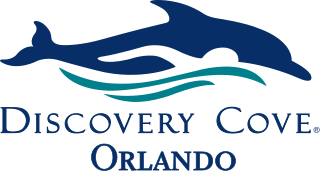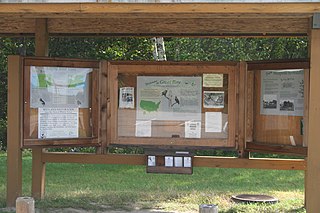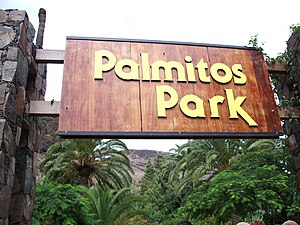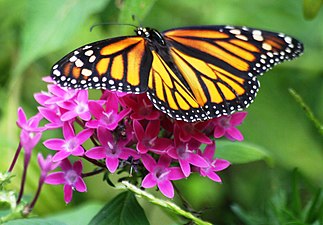Layout
There is a terrace near a fountain, along a path that leads up to the amphitheater where flying birds of prey perform in shows. Next to the amphitheater there is a snack bar, and a small cafe can be found in the park.
One feature of the park is the great wealth of cacti and succulents. There are over 160 different cactus types, and 1000 palm trees of 42 different types. [1]
Parrot-like birds are well represented in the park, but other types of birds can also be found, including swans and ducks. Overall, there are over 1,500 exotic birds of 230 different species. Many fly freely around the park.
Palmitos Park holds Europe's largest butterfly venue, as well as the biggest Orchid collection on the island. [2]
Near the exit - behind the souvenir shop, one can admire hummingbirds that fly very visibly in front of their food.

The bald eagle is a bird of prey found in North America. A sea eagle, it has two known subspecies and forms a species pair with the white-tailed eagle. Its range includes most of Canada and Alaska, all of the contiguous United States, and northern Mexico. It is found near large bodies of open water with an abundant food supply and old-growth trees for nesting.

The South Bruny National Park is a national park located on Bruny Island, Tasmania, Australia, about 50 kilometres (31 mi) south of Hobart. The park contains the Cape Bruny Lighthouse. The highest point of the park is Mount Bruny at 504 metres (1,654 ft).

Gran Canaria is the second most populous of the Canary Islands, an archipelago off the Atlantic coast of Northwest Africa which is part of Spain. As of 2018 the island had a population of 846,717 that constitutes approximately 40% of the population of the archipelago.

African Lion Safari is a family-owned safari park in Southern Ontario, Canada, straddling the cities of Hamilton and Cambridge, located 100 kilometres (62 mi) west of Toronto. Guests may tour seven game reserves, with a total area of about 740 acres, via tour buses or visitors' own vehicles where animals roam freely in contained areas. Accompanying the game reserves is a walking section where exotic birds and primates, as well as the park's herd of Asian elephants, are on display.

Discovery Cove is a theme park owned and operated by SeaWorld Parks & Entertainment, and located in Orlando, Florida. It is the sister park of SeaWorld Orlando and Aquatica Orlando. Visitors to the park can interact with a range of marine animals including bottlenose dolphins.

The Cuban amazon also known as Cuban parrot or the rose-throated parrot, is a medium-sized mainly green parrot found in woodlands and dry forests of Cuba, the Bahamas and Cayman Islands in the Caribbean. Although they have been observed in the wild in Puerto Rico, they are probably the result of escaped pets, and no reproduction has been recorded.

Loro Parque or 'Loro Park' is a 13.5-hectare (33-acre) zoo on the outskirts of Puerto de la Cruz on Tenerife, Spain where it houses an extensive and diverse reserve of animal and plant species. The park was conceived as a paradise for parrots and has developed over the years into one of the biggest attractions of the Canary Islands, with over 40 million visitors. The park keeps orcas, which has attracted criticism from some organisations.

Positioned near the shore of Lake Michigan, the Lincoln Park Conservatory is a conservatory and botanical garden in Lincoln Park in Chicago, Illinois. The conservatory is located at 2391 North Stockton Drive just south of Fullerton Avenue, west of Lake Shore Drive, and part of the Lincoln Park, Chicago community area. The Alfred Caldwell Lily Pool and the North Pond Nature Sanctuary are further to the north along Stockton Drive. Along with the Garfield Park Conservatory on Chicago's west side, the Lincoln Park Conservatory provides significant horticultural collections, educational programs and community outreach efforts.

Cayo Costa State Park is a Florida State Park on Cayo Costa, which is directly south of Boca Grande, 12 miles (19 km) west of Cape Coral and just north of North Captiva Island. The park is accessible only by charter boat, private boat, ferry or helicopter.
Las Águilas-Jungle Park is a zoological and botanical park located near the Los Cristianos beach on the Canary Island of Tenerife. Consisting of 7.5 hectares of jungle with over 500 animals, the park contains a number walking paths with tunnels, suspension bridges, waterfalls, lagoons, and caves. The park also boasts daily flight shows featuring exotic birds and birds of prey.

Tourism is an essential part of the economy of the Canary Islands, a Spanish archipelago located in the Atlantic Ocean, 100 kilometres west of Morocco. Seven main islands and six islets make up the Canary Islands. They had more than 9 million foreign incoming tourists in 2007. Tourists seeking sunshine and beaches first began to visit the Canaries in large numbers in the 1960s. Canary Islands is a leading European tourist destination with very attractive natural and cultural resources.

Kiang West National Park is one of the largest and most important wildlife reserves in the Gambia. It was declared a national park in 1987 and is managed by the Gambia Department of Parks and Wildlife Management.
Rosemary Low is a British aviculturist, ornithologist, conservationist, writer and expert on parrots.

Great Bay National Wildlife Refuge was established in 1992 and is located along the eastern shore of New Hampshire's Great Bay in the town of Newington. The area was formerly part of weapons storage area at Pease Air Force Base, which was closed in 1991. A variety of rich wildlife habitats from uplands to open waters can be found throughout the refuge.

The wildlife of the Philippines includes a significant number of endemic plant and animal species. The country's surrounding waters reportedly have the highest level of marine biodiversity in the world. The Philippines is considered as one of the seventeen megadiverse countries as well as global biodiversity hotspot. In the 2000 Red List of the International Union for the Conservation of Nature and Natural Resources (IUCN), 418 of the country's 52,177 species were listed as threatened.
Uvita de Osa is a small village in southern Costa Rica, on the coast of the Pacific Ocean. It is notable for hosting an annual music event and being home to the Cola de Ballena and the closest village to Marino Ballena National Park. Uvita has grown tremendously over the last 6 years and is the commercial center of Costa Ballena. Many expatriates from northern America and Europe have made Uvita their home. The surfer crowd prefers Dominical while Uvita has become the tourist tour hub of the Costa Ballena region. Tours range from whale watching, ATV tours, and surfing lessons to snorkeling excursions. Uvita offers many lodging options to tourists. Options include hostels, such as the Tucan Hotel, Flutterby House and Cascada Verde. High standard hotels such as Tropical Beach, La Fiore de Bahía. There are also luxurious boutique hotels such as Vista Celestial.

The fauna of the State of California may be the most diverse in the United States of America. Of the Lower 48 conterminous states, California has the greatest diversity in climate, terrain and geology in general. The state's six life zones are the lower Sonoran (desert); upper Sonoran ; transition ; and the Canadian, Hudsonian, and Arctic zones, comprising California's highest elevations. California’s diverse geography gives rise to dozens of different ecosystems, each of which has its own unique native plants and animals. California is a huge state, the 3rd largest in the U.S., and can range broadly in habitat type.

The fauna of the United States Virgin Islands consists of 144 species of birds, 22 species of mammals, 302 species of fish and 7 species of amphibians. The wildlife of the U.S.V.I. includes numerous endemic species of tropical birds, fish, and land reptiles as well as sea mammals. The only endemic land mammals are six species of native bats: the greater bulldog bat, Antillean fruit-eating bat, red fruit bat, Brazilian free-tailed bat, velvety free-tailed bat and the Jamaican fruit bat. Some of the nonnative land mammals roaming the islands are the white-tailed deer, small Asian mongoose, goats, feral donkeys, rats, mice, sheep, hogs, dogs and cats.

Pilancones Natural Park is located in San Bartolomé de Tirajana municipality on the island of Gran Canaria, Spain. Its area is 5794.4 ha. It adjoins Roque Nublo country park to the north, and Fataga protected area to the east. The park plays an important role in soil protection and the replenishment of an aquifer, along which there are several ravines running southward which are of geomorphological interest and landscape value. The pine forests on hilltops are a well-preserved habitat with abundant bird life. The park also harbours several varieties of cactus and spurge, and a number of aquatic habitats. The park takes its name from natural pools, formerly known locally as pilancones, which remain after the runoff of water. Throughout the area there are threatened animal and plant species, and features of scientific interest.





























